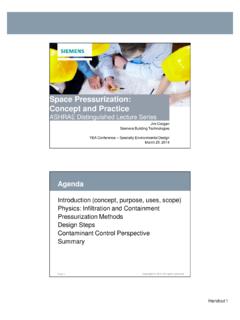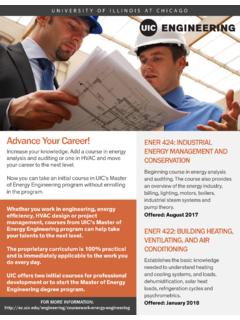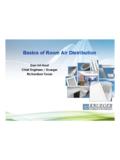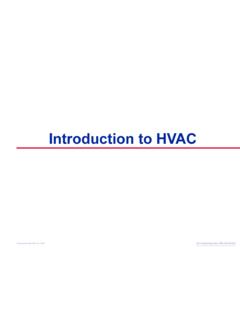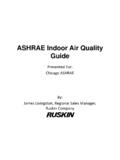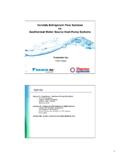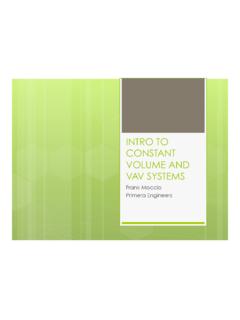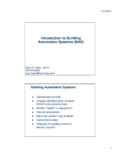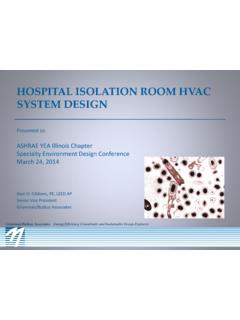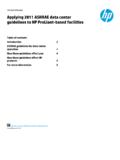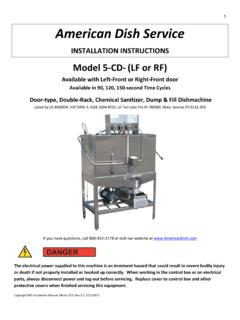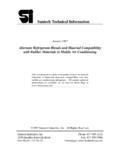Transcription of HVAC Myths and Realities - ASHRAE
1 hvac Myths and Realities Trane Engineers Newsletter Live Series AGENDA Low delta T is unavoidable 55 F supply air temperature is adequate for today s loads ASHRAE Standard 15 has to be updated before new refrigerants can be used Single-zone VAV units do not need hot gas reheat VFDs and affinity laws Small changes in pressure can have a huge impact on airflow for flat fan curves and may cause the system to surge New chilled-water systems need to be variable-primary flow System airflow issues are the fans fault Claims to energy savings Low delta T is unavoidable. Myth Number 1 To n s= ( T GPM)/24 Solving for GPM= (Tons 24) / T Pumping Frictional Head Flow 2 Water HP (bhp)= (GPM head (ft))/3960 Water HP Flow 3 Delta T 3 Transport Energy is low delta T unavoidable? v AHRI Certified Coil Air Flow (VAV) unloading Coil Delta T is low delta T unavoidable? 2015 Engineer s Newsletter Live Coil Selection and Optimization ASHRAE Chilled-Water Coil Selection Chilled-water cooling coils shall be selected to provide a 15 F or higher temperature difference between leaving and entering water temperatures and a minimum of 57 F leaving water temperature at design conditions.
2 1. 3-way control valves Reason 1: 3-Way Control Valves undesirable mixing in variable flow systems CHWS 42 F Bypass 42 F CHWR F Coil LVG 59 F 50% Coil Load CHWR = [(42 x 50) + (59 x 50)] / 100 = Eliminate them! Coil Delta T = 17 F System Delta T = F 0 5 10 15 20 25 50 52 54 56 58 60 CHW Delta T leaving air setpoint 1. 3-way control valves 2. Control setpoint depression Reason 2: Supply Air Setpoint Depression overdriving coil capacity Avoid, limit and return 55 LAT = 16 DT 52 LAT = 11 DT 50 LAT = DT 0 5 10 15 20 25 35 40 45 50 CHW Delta T entering CHW temperature 1. 3-way control valves 2. LAT setpoint depression 3. Warmer chilled water Reason 3: Warmer Chilled Water Supply reduced heat transfer driving force LMTD Chilled water reset only at part load 42 CHWS = 16 DT 47 CHWS = DT 50 CHWS = 5 DT 1. 3-way control valves 2. LAT setpoint depression 3. Warmer chilled water 4. Deficient control valves Reason 4: Deficient Control Valves poor flow control at full and part loads Control Valve Issues 1.
3 Improperly Selected / Oversized 2. Worn-out 3. Unstable control 4. $ (cheap) 5. 3-way valves 1. 3-way control valves 2. LAT setpoint depression 3. Warmer chilled water 4. Deficient control valves Reason 4: Deficient Control Valves poor flow control 8th floor control point 20 ft pd 2nd floor pressure 90 ft pd Specify quality valves specific to use 1. 3-way control valves 2. LAT setpoint depression 3. Warmer chilled water 4. Deficient control valves Reason 4: Deficient Control Valves poor flow control Pressure independent valves? (PIV) 1. Mechanical 2. Electronic Pressure independent valves Not required May be beneficial 1. 3-way control valves 2. LAT setpoint depression 3. Warmer chilled water 4. Deficient control valves 5. Tertiary pumping / bridge tender circuits Reason 5: Tertiary Pumping undesirable mixing is hard to prevent CHWS CHWR Bypass Valve DP Don t mix to the return simply pressure boost 1. AHRI certified coil selections 2. AHU set point limits 3. Chilled water reset only at part load 4.
4 Properly selected / high quality valves 5. Pressure boosting no tertiary mixing Design Delta T and Greater is Achievable Low Delta T is unavoidable. Myth Number 1 55 F supply air temperature is adequate for today s loads. Myth Number 2 full load OA 96 F DB, 76 F WB MA 80 F DB RA 74 F DB, 52% RH 180 160 140 120 100 80 60 40 20 humidity ratio, grains/lb of dry air 110 30 40 50 60 70 80 100 90 dry-bulb temperature, F 80 70 50 40 30 60 full load OA MA RA SA SA 55 F DB (1,500 cfm) full load OA 96 F DB, 76 F WB MA 86 F DB RA 74 F DB, 57% RH 180 160 140 120 100 80 60 40 20 humidity ratio, grains/lb of dry air 110 30 40 50 60 70 80 100 90 dry-bulb temperature, F 80 70 50 40 30 60 full load OA MA RA SA SA 55 F DB (800 cfm) RA' full load OA 96 F DB, 76 F WB MA 89 F DB RA 74 F DB, 52% RH 180 160 140 120 100 80 60 40 20 humidity ratio, grains/lb of dry air 110 30 40 50 60 70 80 100 90 dry-bulb temperature, F 80 70 50 40 30 60 full load OA MA RA SA SA 51 F DB (630 cfm) SA' Improving Dehumidification Cool and reheat Face-and-bypass dampers Reduce airflow Dual paths Desiccants full load OA 96 F DB, 76 F WB MA 86 F DB RA 74 F DB, 52% RH 180 160 140 120 100 80 60 40 20 humidity ratio, grains/lb of dry air 110 30 40 50 60 70 80 100 90 dry-bulb temperature, F 80 70 50 40 30 60 full load OA MA RA SA SA 52 (55) F DB (800 cfm) CA SA' Type III Series Desiccant (CDQ) MA SA 55 F DB 64% RH 42 gr/lb (43 F DP) 50 F DB 97% RH 52 gr/lb MA' 80 F DB 50% RH 77 gr/lb (60 F DP) (10,000 cfm) 75 F DB 67% RH 87 gr/lb (64 F DP) 8-12 rph CA C full load OA 96 F DB, 76 F WB MA 81 F DB RA 74 F DB, 52% RH 180 160 140 120 100 80 60 40 20 humidity ratio, grains/lb of dry air 110 30 40 50 60 70 80 100 90 dry-bulb temperature, F 80 70 50 40 30 60 full load OA MA RA SA SA 63 F DB (1,350 cfm) CA MA' SA' 55 F supply air temperature is adequate for today s loads.
5 Myth Number 2 Single-zone VAV units do not need hot gas reheat. Myth Number 3 outdoor condition sensible load latent load space SHR supply airflow outdoor airflow space temp supply air temp peak DB 96 F DB, 76 F WB 29,750 Btu/h 5,250 Btu/h 1,500 cfm 450 cfm 74 F F Classroom Example basic CV system 29,750 Btu/h (74 F Tsupply) 1,500 cfm = Jacksonville, Florida 180 160 140 120 100 80 60 40 20 humidity ratio, grains/lb of dry air 110 30 40 50 60 70 80 100 90 dry-bulb temperature, F 80 70 50 40 30 60 OA MA RA SA Jacksonville, FL 84 F DBT 76 F DPT (450 cfm) 77 F DBT 63 F DBT (1500 cfm) part load CV 96 F DBT 68 F DPT (450 cfm) 81 F DBT 74 F DBT 52% RH 55 F DBT (1500 cfm) ( tons) full load CV peak DPT OA MA SA peak DBT OA MA RA SA RA 74 F DBT 67% RH Example: K-12 Classroom OA MA RA SA 84 F DBT 76 F DPT (450 cfm) 77 F DBT 63 F DBT (1500 cfm) ( tons) 96 F DBT 68 F DPT (450 cfm) 81 F DBT 74 F DBT 52% RH 55 F DBT (1500 cfm) ( tons) 180 160 140 120 100 80 60 40 20 humidity ratio, grains/lb of dry air 110 30 40 50 60 70 80 100 90 dry-bulb temperature, F 80 70 50 40 30 60 peak DPT OA MA SA MA RA SA RA 74 F DBT 67% RH part load CV full load CV Jacksonville, FL peak DBT OA Example: K-12 Classroom peak DPT day zone humidity, %RH 67% cooling load, tons fan airflow, cfm 1500 mild/rainy day zone humidity, %RH 73% cooling load, tons fan airflow, cfm 1500 constant-speed fan Example: K-12 Classroom Hot Gas Reheat packaged DX units condenser MA reheat valve CA reheat coil evaporator constant-speed fan constant-speed fan with hot gas reheat 60% 1500 55% 1500 Space humidity is maintained Example.
6 K-12 Classroom peak DPT day zone humidity, %RH 67% cooling load, tons fan airflow, cfm 1500 mild/rainy day zone humidity, %RH 73% cooling load, tons fan airflow, cfm 1500 compressor energy SA OA 1500 cfm EA Improved Part-Load Dehumidification RA 450 cfm 55 F 96 F DBT 68 F DPT 1050 cfm zone 74 F OA MA RA SA 84 F DBT 76 F DPT (450 cfm) 77 F DBT 63 F DBT (1500 cfm) ( tons) 96 F DBT 68 F DPT (450 cfm) 81 F DBT 74 F DBT 52% RH 55 F DBT (1500 cfm) ( tons) 180 160 140 120 100 80 60 40 20 humidity ratio, grains/lb of dry air 110 30 40 50 60 70 80 100 90 dry-bulb temperature, F 80 70 50 40 30 60 peak DPT OA MA SA MA RA SA RA 74 F DBT 67% RH part load CV full load CV 84 F DBT 76 F DPT (450 cfm) 79 F DBT 55 F DBT (900 cfm) ( tons) 74 F DBT 57% RH part load SZVAV Jacksonville, FL Example: K-12 Classroom peak DPT day zone humidity, %RH 67% cooling load, tons fan airflow, cfm 1500 mild/rainy day zone humidity, %RH 73% cooling load, tons fan airflow, cfm 1500 variable-speed fan constant-speed fan constant-speed fan with hot gas reheat 60% 1500 55% 1500 57% 900 60% 750 Example: K-12 Classroom SZVAV Dehumidification Performance VAV may be enough Consider hot gas reheat for.
7 Even lower space humidity levels Widely varying loads Oversized units 180 160 140 120 100 80 60 40 20 humidity ratio, grains/lb of dry air 110 30 40 50 60 70 80 100 90 dry-bulb temperature, F 80 70 50 40 30 60 OA MA RA SA 96 F DBT 68 F DPT (450 cfm) 80 F DBT 58 F DBT (1750 cfm) 96 F DBT 68 F DPT (450 cfm) 81 F DBT 74 F DBT 52% RH 55 F DBT (1500 cfm) peak DPT OA MA MA 74 F DBT 56% RH Oversized SZVAV full load SZVAV 84 F DBT 76 F DPT (450 cfm) 78 F DBT 58 F DBT (1050 cfm) 74 F DBT 59% RH part load SZVAV Jacksonville, FL MA RA SA peak DBT OA SA SA RA RA Example: K-12 Classroom Avoid Oversizing! Oversizing supply airflow leads to: Warmer supply-air temperature Less dehumidification (in non-arid climates) Elevated indoor humidity Examples include: Auditoriums Gymnasiums Church sanctuaries Etc. Humidity Control with SZVAV Avoid oversizing equipment Verify proper fan speed and discharge air temperature setpoints Equip the unit with hot gas reheat, if necessary Single-zone VAV units do not need hot gas reheat Myth Number 4 Slap on a VFD and you are entitled to get full advantage of the affinity laws.
8 Myth Number 4 = Speed3 Savings Background: 1. Fans, pump impellers and other dynamic compression devices. 2. Application limited to systems with only frictional flow losses. 3. Ignoring changes in device efficiency at different conditions. If and only if the above are true then: 1. Pressure varies proportionally to the square of the impeller speed. 2. Flow produced varies proportionally to the impeller speed. 3. Power (BHP) required varies in a cubic proportion to the impeller speed. The Affinity Laws dynamic compression fans/impellers The Affinity Laws Graphically dynamic compression fans/impellers Device performance in frictional pressure loss systems Pressure is proportional to the speed squared Flow is proportional to the speed Power is proportional to the speed cubed 75 50 25 0 100 0 25 50 75 100 flow/pressure/power (%) speed (%) pressure flow power Systems and the Affinity Laws compliant systems Systems that comply Cooling towers Single zone VAV air systems. Cooling Tower Fans affinity laws Cooling Tower 85 F 100 F Cooling Tower 60 HZ OFF 15 kW 75 50 25 0 100 0 25 50 75 100 speed/pressure/power (%) flow (%) speed pressure power 100% flow 100% pressure 100% power P Cooling Tower Fans affinity laws Cooling Tower 85 F F Cooling Tower 60 HZ OFF kW For Free Discharge Fans W2 = W1 x (S2 / S1)3 W2 = 15 kW x (30 / 60)3 W2 = kW 75 50 25 0 100 0 25 50 75 100 speed/pressure/power (%) flow (%) speed pressure power P Systems and the Affinity Laws non-compliant systems Systems that don t comply: Chilled water Hot water MultiZone VAV Condenser water hvac cooling units hvac heating units (HP) Non-compliant characteristics.
9 Control valves and setpoints Fixed lift Refrigeration lift / heat exchangers / minimum flows 75 50 25 0 100 speed/pressure/power (%) VPF Chilled Water Systems systems and the affinity laws 0 25 50 75 100 flow (%) speed pressure power Non-compliance factors Pump minimum speed limits Pump Minimum Speed Impact VPF chilled-water systems 0 25 50 75 100 flow (%) pump min speed 75 50 25 0 100 speed/pressure/power (%) Non-compliance factors Pump minimum speed limits 33% minimum speed pressure power Differential Pressure Control Impact VPF chilled-water systems 0 25 50 75 100 flow (%) DP pressure setpoint 75 50 25 0 100 speed/pressure/power (%) Non-compliance factors Pump minimum speed limits A fixed pressure control setpoint 20 ft. setpoint 80 ft. frictional loss speed power Heat Exchanger Minimum Flow Impact VPF chilled-water systems 0 25 50 75 100 flow (%) HX min flow 75 50 25 0 100 speed/pressure/power (%) Non-compliance factors Pump minimum speed limits A fixed pressure control setpoint Heat exchanger minimum flow limits 50% minimum flow pressure power Combined Limit Power Impact VPF chilled-water systems Non-compliance factors Pump minimum speed limits A fixed pressure control setpoint Heat exchanger minimum flow limits 0 25 50 75 100 75 50 25 0 100 speed/pressure/power (%) flow (%) Pump min speed HX min flow DP setpoint affinity power Non-compliance factors Pump minimum speed limits A fixed pressure control setpoint Heat exchanger minimum flow limit 70% High HX Minimum Flow Impact VPF chilled-water systems 0 25 50 75 100 flow (%) HX min flow 75 50 25 0 100 speed/pressure/power (%) pressure power Systems that comply Cooling towers Single zone VAV hvac systems.
10 Systems that don t comply Chilled water Hot water Condenser water Multi-zone VAV hvac cooling units hvac heating units (HP) Slap on a VFD and you are entitled to get full advantage of the affinity laws. Myth Number 4 Small changes in pressure can have a huge impact on airflow for flat fan curves and may cause a fan system to surge. Myth Number 5 1100 RPM 900 RPM 700 RPM 500 RPM 50% WOCFM 60% 70% 80% 90% Forward Curved (FC) Fan Static pressure inches CFM in 1000s peak pressure Small Changes in Pressure Do not select region Far from peak some may select here 6 5 4 3 2 1 0 0 4 8 12 16 20 Fan Performance Test 7 6 5 4 3 2 1 0 0 2500 5000 7500 10000 12500 15000 17500 20000 22500 airflow (cfm) total static pressure (in H2O) less restricted wide open blocked off restricted 14 12 10 8 6 4 2 0 Brake horsepower (bhp) 1100 RPM 900 RPM 700 RPM 500 RPM 50% WOCFM 60% 70% 80% 90% Forward Curved (FC) Fan static pressure inches CFM in 1000s Pressure = f(Airflow) 6 5 4 3 2 1 0 0 4 8 12 16 20 1100 RPM 900 RPM 700 RPM 500 RPM 50% WOCFM 60% 70% 80% 90% static pressure inches CFM in 1000s Two Different Systems actual system Design system 6 5 4 3 2 1 0 0 4 8 12 16 20 Forward Curved (FC)

